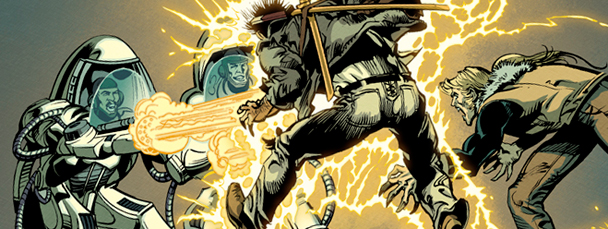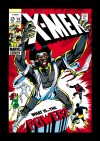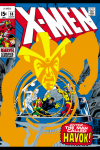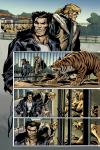|

By Ben Morse
Neal Adams already stood tall as a creative giant in the comic book industry by 1969, but when he made his way to Marvel with UNCANNY X-MEN #56, it proved a watershed moment for what would become perhaps the most popular franchise in the history of the medium.
With the title on the verge of cancellation, Adams, along with collaborator Roy Thomas, infused UNCANNY X-MEN with an energy and inventiveness that would only stay execution for 10 issues, but left a mark on not just the team, but Marvel and indeed the industry as a whole that changed the game. The mutants would rally a few years later to surge in popularity while Adams’ work proved that properties written off could be reinvigorated and opened up a new era of creative boldness.
On August 1, Adams makes his long-awaited return to Marvel’s mutants with FIRST X-MEN, a five-issue limited series for which he will provide art while sharing writing chores with Christos Gage. Marvel.com had the opportunity to speak with Neal about his own past with the X-Men as well as what he has planned to fill in the gaps of their early years.
Marvel.com: Going back in time a bit, what did your run on the original UNCANNY X-MEN series mean to you?
Neal Adams: I felt it was significant to change the approach of group characters or else comics wouldn’t get out of the rut of avoiding group characters. The standard plot was to have a problem, to break the characters into groups of two, have them solve their individual problems, and then come back together and fight the bad guy. Of course, we now know that interweaving the characters, sometimes focusing on them together, sometimes vignette-ing them, sometimes having them respond to one another within the situations was the much better way to go. I got to show that in my 10 issues of X-Men, and I hoped by doing that, I would remove the fear and loathing of doing group characters. It worked. Of course, that is not to say that Jack Kirby and John Buscema were not able to work on the problem as well, but in this series, I got to show, in a way, how easy it was.
Marvel.com: It has since gone on to be very fondly remembered and seen as a pivotal piece of Marvel’s evolution, but how did you approach your UNCANNY X-MEN tenure personally and professionally at the time?
Neal Adams: I went to see the master, Stan Lee. I wanted to work in the “Marvel style,” which at that time was the artist draws the story, and Stan puts in the dialogue; that was described to me by Jim Steranko, when he visited me at the DC Comics production room one day. Stan offered to let me draw any title that they had at the time. I asked him what [their worst selling title was]. He told me it was [UNCANNY X-MEN] and they were going to cancel it in two issues. So I told Stan that I would love to draw the X-Men. He explained, “But I just told you we were going to cancel it in two issues.” “Well, in that case, Stan, that means no one will be paying much attention, and I can pretty much do what I want.” Stan reckoned that that was true, but then he made me promise that once Marvel canceled the book, I would do an “important” title like AVENGERS. I agreed. Unfortunately, Stan would not be doing the dialoguing, that task was to be left to Marvel’s bright new up and comer, Roy Thomas.
The book was in the shambles. Magneto was dead. They had managed to kill off Professor X, but not just kill him off, let him get sick, lose his powers, get weaker and weaker, die, and then get buried in a very emotional scene. But I told Roy that I was going to bring Professor X back to life. Roy said, “I don’t know, Neal. He’s pretty dead.” I solved that problem in a flashback by having Changeling take his place and, in effect, die in his place, while Professor X worked on an interplanetary invasion. Of course, it was quite a shock when it was revealed that Professor X was not only alive, but that Jean Grey was helping Changeling fake his way through pretending that his powers were being drained as he got sicker. Of course, the characters needed a little costume brightening up, and I felt the story that I was left to do gave me a real opportunity to create a new, dramatic super hero out of Scott Summer’s brother, Alex.
And so was born, Havok. Later on, I got to play with Jack Kirby’s Sentinels, with a new generation master and creator; I created Sauron, I created a big handful of new mutants in Ka-Zar’s Savage Land, and finally I brought Magneto, not only back to life, but curiously since he had always worn his helmet, to finally show the face of Magneto in a very, very dramatic way, if I may say. I would say Roy Thomas topped me with the line, “I guess clothes do make the man.”
Marvel.com: What about the X-Men appeals to you?
Neal Adams: What appeals to me is that we can all relate to the X-Men. We are all different in some way from everyone we know. Our uniqueness makes us [both] special and scarily different from everyone else. And, of course, we see this difference as being profound, and life involving, whereas, for the most part, other people ignore it, and think of us as one of the crowd. How much like the X-Men is that? I would say that Jack Kirby and Stan Lee touched on a very significant part of all of our personalities with the X-Men.
Marvel.com: As a fan and from the standpoint of someone who helped shape the franchise, how closely have you followed the X-Men since your run?
Neal Adams: I have tried to follow the X-Men completely, but it’s sort of like a cell dividing itself when you spread your attention over what seems to be now 100 or more characters. It’s a little hard to focus on all the individuals. So I tend, I think like many others, to focus on a core group. Which, curiously enough, with minor exceptions, turns out to be those original X-Men. I would add to that Wolverine, Emma Frost, Kitty Pryde, Gambit, and a few others, of course; but [mainly] Beast, in his new incarnation, the world shaker Marvel Girl aka Phoenix, Iceman, Cyclops and Angel. And, of course, Havok.
Marvel.com: Where did the idea for what will be FIRST X-MEN come from?
Neal Adams: I had presented a potential idea for major project for Marvel, but new [editor-in-chief] Axel Alonso suggested, for the beginning, I might like to focus on a character like Wolverine, as my reintroduction to the Marvel world. Of course, I look upon any editorial direction as a challenge, and I know that, myself, and many others, have unresolved issues with Wolverine. For example, what happened to his memory? Why did it happen? Where did he come from really? Why does he feel so alienated from the X-Men, and yet keeps coming around to hang around for a few months, and then goes away again? Then I get the really significant question: If mutants have been born increasingly in the population, is it possible that [there was] someone who intended and actually did try to protect them before Professor X took up the mantle? And wouldn’t that person be Logan? He certainly was old enough. And unlike Sabretooth, underneath it all, he’s sensitive and caring. If we ignore his gruff exterior, he is the perfect mercenary leader to a gang of escapee mutants. And, suddenly, I saw a whole history unfolding before my eyes. And that was the story I presented to Axel and the editorial staff. They seemed to love it and we are doing it.
Marvel.com: Did it morph from a different pitch or rough concept?
Neal Adams: Yes, it did morph from the pitch to the final concept through a series of outlines. There was disagreement at first, but I won’t tell you what the disagreement was, because it is my true belief that, if this series does move on, aspects of those story concepts will be added to the scenario in future books. And I don’t want to spoil it for anyone. We decided in the end to stay closer to the mutant/mutant focus, and how it related to the current storyline so that the audience could see a clear and distinct pure evolution of the story from then to now. And side issues could wait for future stories. And, if I may parenthetically, they are juicy.
Marvel.com: What made you want to delve into the period before the X-Men were formed?
Neal Adams: I would suggest that I did not delve into another era, but simply told the untold story. Because, after all, it doesn’t make real sense that the X-Men began in full costume in the living room of Charles Xavier, who was at that point bald and in a wheelchair. Many things must have lead up to this moment, and so, I simply told part of that story. I believe there are many other parts.
Marvel.com: What are the big questions about the X-Men, mutants, etc. that you felt were most glaringly unanswered and wanted to explore in this series?
Neal Adams: Here is a list:
How did Xavier go from brilliant, young scientist, investigator of UFOs, and all manner of scientific exploration to this intense, driven protector of all the mutants of the world, dedicating, in effect, his life, to these creatures who would only be victims of an uncaring society?
What part did Wolverine, whose age we don’t exactly know, play in this evolutionary process? Could it be none? Of course not.
What did Wolverine do that causes Sabretooth to hate him so? Sabretooth, you know, hates him with a rage that crawls along the edge of insanity. How did this happen? Nobody is that terrible. There had to be a reason.
Would Wolverine succeed? Or would he, in the end, have to seek out somebody like Charles Xavier because he simply couldn’t do the job?
Marvel.com: Where do we find Charles Xavier in this story?
Neal Adams: Charles Xavier is semi-engaged to Moira MacTaggart. He is a young, 17-year old student [at] Oxford who is hiding in his athleticism, but, of course, is not in a wheelchair. I can tell you that I argued for him to have a full head of hair, but the history gurus at Marvel insisted that he was bald at this age. But bald or no, he was a young man, looking forward to a brilliant future, a wife, children, and a satisfying and fulfilling life, bathed in the glow of academia. He certainly didn’t want some rain-bedraggled werewolf showing up on his doorstep with the dead body of a mutant—whatever they were. This was not part of his plan.
Marvel.com: What are the differences between Charles Xavier and Professor X, between Erik Lensherr and Magneto?
Neal Adams: In our story, Xavier wants nothing to do with mutants. He has “passed” in the human community because no one can see that he is a mutant, visually. He is not a “freak.” Erik Lensherr is a Nazi hunter. He is a bloody revenger. And that fills his days. That he is a mutant is simply a means to an end. In modern times, of course, that has changed—not that he wouldn’t give a whack at a Nazi if given the opportunity, but he has much grander goals today, so we can see this natural evolutionary process of taking Xavier from irresponsible, self-indulgent, to, perhaps, one of the most responsible people on earth, and Erik, refocusing his anger at Nazis to the new racist abomination: hostility against mutants.
Marvel.com: Why did you want to place Wolverine into this part of the X-Men’s past?
Neal Adams: I didn’t actually want to place him, I think he was there already. His age makes him the perfect candidate. His sensibilities have always been to protect mutants, no matter how crude and rough he is. I don’t actually see that there was another choice. It flows, as my mother would say, like water.
I am not necessarily in favor of people looking at Wolverine with sympathy, but I am in favor of people looking at Wolverine with understanding for what he has gone through. We needn’t like Wolverine for it, but we do need to understand where he comes from.
Marvel.com: How do Wolverine and his presence affect the traditional Xavier/Magneto dynamic?
Neal Adams: It doesn’t really affect it at all. We were very contentious to keep every dynamic that exists today intact. But simply add understanding and clarification. I consider the history of each X-Man to be sacrosanct. And each contribution should be a creative build to all that has gone before.
If Xavier existed a generation before, the history would be totally different. It’s just the deal of the cards that bring Wolverine into this position. If he had a choice, I suspect he’d rather not be that person, because it’s a very, very tough job. And he knows, and I think we all know, that Xavier would have done it better.
Marvel.com: What is the threat facing Xavier, Wolverine, Magneto, etc. in FIRST X-MEN?
Neal Adams: The primary antagonist is human society, in a more primitive state than we find them today. These mutants could be aliens, could be magical demons. In fact, mutants are the last thought that anybody would have. Monsters would be the first thought. Then, of course, we have the military industrial complex, who we all know and love, who wish to use these creatures, whatever they are, to their advantage, by reading the minds of their enemies, by weaponizing them, by cutting them open and finding out what makes them tick; or, by any number of invasive horrors that we as humans indulge in. At least today, the Marvel world knows that they are mutants, which puts them into a specific and not unknown category. Back then, monsters.
Marvel.com: How did you approach creating the new characters for this series, and are there any you are particularly fond of?
Neal Adams: Since the story takes place in the past, I couldn’t easily create characters that would have a gigantic if not historical affect in the present. So there were limitations, and I worked within those limitations. That is not to say that Christos did not work with me, of course he did, and between us, we came up with one of our favorite characters: Meteor, a seething, angry, yet very interesting character. My favorite character is a 13-year-old African American kid who calls himself Bombastic Aghast, for no reason that I understand. Everyone calls him Bomb. When we meet him for the very first time, out of control, he blows himself up. What happens after that I cannot tell you because that would ruin the story. But I suspect you will care for him just as we do.
Marvel.com: How important was it for this series to be set firmly in continuity not just for the X-Men but the Marvel Universe?
Neal Adams: Back in the day, we didn’t pay much attention to whether it was continuity, but rather if the book was going to be canceled. Nowadays, with all the licensing, movies and television, people are taking comic characters very seriously. It’s not up to me to say whether or not this is good or not. I am just making the observation. So the relative importance of the characters retaining their continuity is becoming greater with time. Sometimes this probably gets in the way. For me, it does not. I think of it as all these little scraps of questions and answers have been left along a path for me to answer. And I have a grand old time doing it.
Marvel.com: What has it been like collaborating with Christos Gage?
Neal Adams: I think confusing and difficult for Christos, and at the same time, if I were to listen to him this last weekend, a great rollicking ride, with new things happening all the time. I am very comfortable working with Christos because he “gets it.” And he deals incredibly well with any problems that come up, so I couldn’t be happier.
Marvel.com: How are you splitting responsibility with him?
Neal Adams: It’s my story; it’s editorial and Christos’ responsibility to make sure that we fit into the X-Men history without stepping on too many toes. Dialogue, is of course, thrown back and forth, but he is the one responsible for seeing editorially, it will live up to Marvel’s standards. Not an easy job. It’s my job to see that the dialogue carries the story.
|














